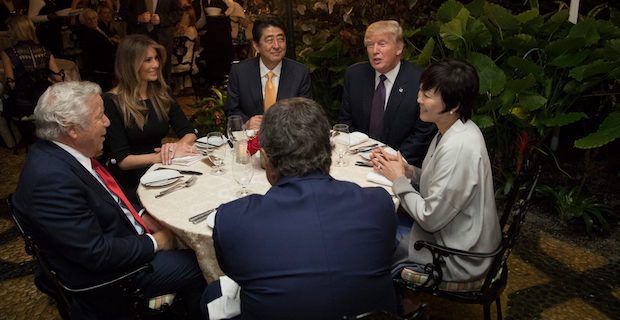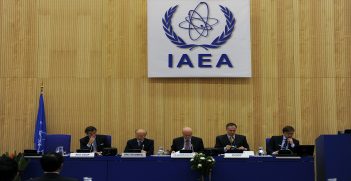Where are the Diplomats in Trump’s Sidelined State Department?

As President Trump embarks on his first foreign trip, his unusual approach to US diplomacy will be evident. The preference for military officers over diplomats, while extreme, is not a radical departure from the history of American foreign policy, but his focus on hard power and personal relationships is unsustainable.
There is growing evidence that the Trump administration is sidelining the Department of State and developing a military-centric foreign policy. Against the background of the appointment of a substantial proportion of former military officers to senior administration positions, the New York Times reported recently that the US Department of State “will remain largely leaderless until well into 2018”. Some 200 senior state department positions requiring senate confirmation are on hold. Reportedly, the Secretary of State Rex Tillerson plans to first restructure the department before sending nominations to the White House, after which they would go to the senate for approval, where the process can take months.
The situation has been criticised on many fronts. The same paper editorialised that Tillerson’s sluggishness in the face of pressing foreign policy challenges from adversarial states such as North Korea, Syria, Iran, Russia and China is “dangerous”. Leading neoconservative, Elliott Abrams, speculated that the delays could leave ostensibly liberal internationalist career diplomats in senior state department positions for almost a quarter of the president’s four-year term. This unusually slow pace in making senior appointments is matched by the administration’s lethargy in nominating new ambassadors who also require senate approval.
Tillerson’s low profile and delay in pushing to fill senior appointments at home and abroad may signal the Trump administration’s pro-military instincts. Moreover, those instincts are underscored by an apparent rejection (or lack of awareness) of diplomatic norms, such as tact, civility and restraint, and perhaps even a rejection of diplomacy itself as a means for advancing US interests.
However, it would be a mistake to see Trump’s foreign policy approach as unique in American history. Rather, his administration’s actions and statements thus far reflect certain distinguishing characteristics of American diplomacy that I have written about in the past. But it does appear that Trump will exacerbate each of them to America’s, and the world’s, disadvantage.
One characteristic of American diplomacy is that the United States has a history of distrusting the institution of diplomacy. Trump’s frequently injudicious statements and tweets are not simply the outpourings of a mercurial temperament; they are partly grounded in a distinctive American tradition of ‘anti-diplomacy’, one that accepts participation in diplomacy while being reluctant to acknowledge the usefulness of diplomatic norms and practices. In this regard, President Trump is the consummate anti-diplomat.
A second is that US administrations tend to privilege hard power policies over soft power policies. In Joseph Nye’s famous distinction, the hard power agents of brute force in the US Department of Defense eclipse the soft power agents of diplomatic persuasion in the Department of State. The appointment of so many former military officials to senior administration posts, the proposed increases in defence spending and deep cuts in the state department’s budget reinforce a pre-existing American preference for hard power over soft power.
Another characteristic is the US preference for bilateral over multilateral diplomacy. In his various meetings and telephone calls with foreign leaders, we see Trump’s preference for one-on-one (bilateral) exchanges. He appears to see American diplomacy in terms of his personal relations with foreign leaders. True, those are important. But diplomatic relations are conducted at multiple levels, and this is where the state department and its network of diplomatic missions worldwide provide ballast.
American diplomacy also exhibits a strong cultural disposition toward a direct, low-context negotiating style. A high-context negotiating style emphasises process and relationship-building alongside indirect, implicit, non-verbal forms of communication. In contrast, a low-context negotiating style focuses on tangible results and uses direct and explicit communication. This American low-context tendency will likely be taken to an extreme given Trump’s transactional, art-of-the-deal view of negotiation. Trump and Tillerson, both with business backgrounds, may soon discover that corporate norms are an uncomfortable fit with diplomacy.
These characteristics provide criteria with which to evaluate this administration’s relationship to the institution of diplomacy as a key element of the global order. In the current hyper-partisan environment, President Trump’s early sidelining of the state department in favour of the military, and the projected budget cuts at State suggest that American diplomacy over the next nearly four years is likely to be highly personalised and less effective—dare I say, ‘less great’—than it might otherwise be.
Professor Geoffrey Wiseman is director of the Asia-Pacific College of Diplomacy at the Australian National University. This piece draws on his article ‘Distinctive Characteristics of American Diplomacy’, published in The Hague Journal of Diplomacy.
This article is published under a Creative Commons Licence and may be republished with attribution.





